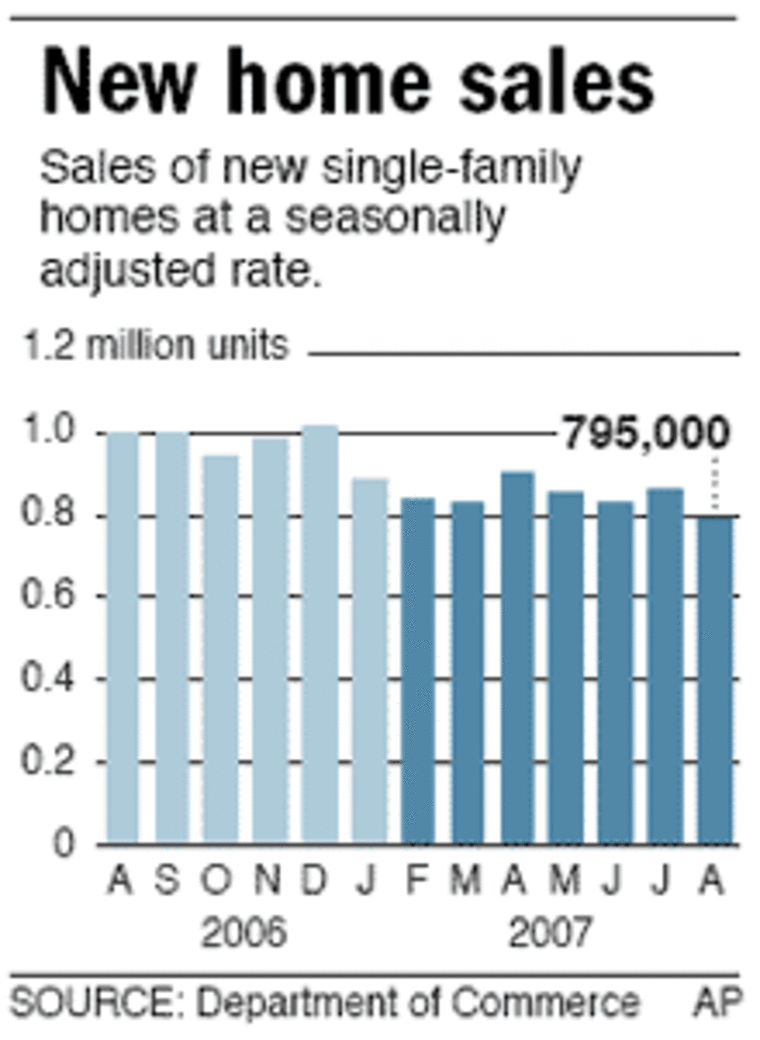New-homes sales tumbled in August to the lowest level in seven years, a stark sign that the credit crunch is aggravating an already painful housing slump.
Sales of new homes dropped by 8.3 percent in August from July, the Commerce Department reported Thursday, driving down sales to a seasonally adjusted annual rate of 795,000 units. That was the lowest level since June 2000, when sales clocked in at a pace of 793,000.
The home sales report came on the same day that the government reported a relatively brisk business growth rate in revised figures for the second quarter. But the 3.8 percent pace was less than previously estimated and it occurred before the credit crisis and its repercussions across the broad spectrum of the economy had taken hold.
The median sales price in August fell by 7.5 percent from a year earlier to $225,700. That was the biggest drop in percentage terms in nearly 37 years. The median price is the middle point at which half sell for more and half for less. The average sales price dropped by 8 percent in August from a year earlier to $292,000. That was the biggest decline in 17 years.
Sales fell in the South and the West in August compared with July. Sales, however, rose in the Northeast and Midwest.
The new-homes sales report, combined with other recent economic reports showing a sharp drop in demand for big-ticket manufactured goods in August, suggested the economy lost momentum as it headed into the fall.
On Wall Street, investors looked to the weak home sales report as justification for another rate cut by the Federal Reserve. The Dow Jones industrial average was up around 20 points in morning trading.
Another report issued by Commerce showed the economy staged a rebound in the spring before a credit crisis raised new fears about longer-term business health.

The economy's 3.8 percent growth rate in the April-to-June quarter was the strongest showing in just over a year. Although the new reading for the second quarter was slightly less robust than a previous estimate of a 4 percent growth rate, it nonetheless marked a substantial improvement over the feeble 0.6 percent growth rate registered in the prior quarter.
Gross domestic product is the value of all goods and services produced within the United States and is considered the best barometer of the country's economic health.
The increase in the rate of growth, though, is likely to be fleeting. A deepening housing slump and a painful credit crunch since the spring has darkened the mood of individuals and businesses alike. That has led analysts to predict that economic growth has slowed considerably in the quarter that ends Sunday.
The National Association for Business Economics says it believes growth in the third quarter — the period from July through September — slowed to a pace of around 2.4 percent. It predicts the growth rate in the final three months of this year will be around 2.5 percent. Others think growth will turn out to be weaker than those projections.
Fears that the troubled housing market and credit problems could short-circuit the six-year-old economic expansion have shaken Wall Street. The biggest worry is that people and businesses will cut back on their spending and investment, throwing the economy into a tailspin.
Former Federal Reserve chief Alan Greenspan, in an interview with The Associated Press last week, said the odds of a recession are now higher than one-in-three but are still under 50 percent.
To help protect the economy from the ill effects of the housing slump and credit crunch, the Federal Reserve last week slashed a key interest rate. The hope is that lower rates will induce more spending and investment and thus energize overall economic activity. Analysts believe another rate cut will come in late October.
Critical to the economy's outlook is the health of the jobs market.
In another report, fewer people signed up for unemployment benefits last week, raising hopes that the recent weakness in the jobs market won't be long lasting.
The second-quarter's bounce-back came even amid the continuing strain of a housing slump. Builders slashed spending on housing projects by 11.8 percent, on an annualized basis, in the spring. Other businesses, though, boosted investment and spending in the second quarter on such things as equipment and software and construction of new plants, office buildings and other things.
Company profits also gained ground in the spring. One measure showed that after-tax profits rose by 5.2 percent in the second quarter, up from a 1.5 percent gain in the first quarter.
But a credit crunch, which took a turn for the worse in the third quarter, could put pressure on companies and lessen their appetite to invest. Sales of big-ticket manufactured goods plunged in August.
The free flow of credit is important to the smooth functioning of the national economy. If credit becomes too difficult to get, it can put a damper on peoples' ability to buy big-ticket items such as homes, cars and appliances. And it can crimp businesses' capital investment and hiring.
The worst housing slump in 16 years is being painfully felt. Higher interest rates squeezed homeowners, especially "subprime" borrowers with blemished credit or low incomes. Foreclosures set records and late payments spiked. Lenders were forced out of business. Hedge funds and other investors in subprime-related mortgage securities got clobbered.
All that has caused stocks on Wall Street to careen wildly in the past few months.
President Bush, meanwhile, is continuing to get low marks for his economic stewardship. Just 37 percent approve of his handling of the economy in September, down from 41 percent in August, according to an AP-Ipsos poll.